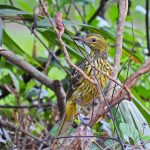GREEN ORIOLE
Sharon: This Australian Oriole has a very distinctive call that echos through the Rainforest and Bushlands, but I have heard them sing lots of other songs. So for that reason, I would call them one of Australia’s Songbirds.
The Green Oriole: A Jewel of Australia’s Tropical North
Deep within the lush canopies of northern Australia, a flash of emerald and gold catches the eye. This is the Green Oriole, a bird whose beauty and song embody the very spirit of the tropics.
Vivid Plumage: Nature’s Sunlight Filter
Imagine standing in a monsoon forest as shafts of sunlight pierce the leafy canopy. This is the palette from which the Green Oriole seems painted:
- Back and Wings: A deep, olive-green, blending seamlessly with the dense foliage.
- Underbelly: Bright yellow-green, reminiscent of sunlit leaves.
- Eyes and Beak: Contrasting dark eyes and a sturdy, slightly curved beak designed for a varied diet.
The visual impression is both striking and soothing, a living echo of the forest itself.
The Song of the Tropics
Close your eyes and listen: a series of clear, fluty whistles drift through the humid air. The Green Oriole’s call is at once mellow and melodious, weaving through the trees and announcing its presence. This song is more than just beautiful—it’s a vital tool for communication, territory defence, and courtship.
- Auditory Experience: Rich, whistling notes, sometimes repeated in haunting refrains.
- Soundscape: Blends harmoniously with the backdrop of rustling leaves and distant water, creating a multi-layered symphony unique to Australia’s north.
Home Among the Trees
| Region | Habitat Types |
|---|---|
| Northern Australia | Monsoon forests, mangroves, woodlands |
| Top End (NT), Kimberley (WA), NE Queensland | Dense coastal forests, urban gardens, parks |
Whether hidden high in the branches or visiting a city garden, the Green Oriole brings a splash of tropical vibrancy wherever it goes.
A Gourmet of the Wild
The Green Oriole’s diet is as varied as the landscape it inhabits:
- Insects: Foraged from bark and leaves, helping control pest populations.
- Fruits: Especially fond of figs, which provide energy and hydration.
- Nectar: Sipped from flowers, supporting pollination.
Role in the Ecosystem:
- Seed Dispersal: By eating figs and other fruits, Green Orioles scatter seeds across the forest, supporting new growth and maintaining plant diversity.
- Predation: By consuming insects, they keep the delicate balance between plants and herbivores.
The Fig Tree Connection
There is a special bond between the Green Oriole and the fig tree. As the oriole feasts on ripe figs, it inadvertently spreads the seeds far and wide, playing a crucial part in the life cycle of these keystone trees. The scent of sweet fruit and the soft texture of figs are as much a part of the oriole’s world as the rustle of leaves and the warmth of the sun.
Conservation: A Delicate Balance
While the Green Oriole is currently not considered threatened, its survival is tied to the health of its habitat. Dense forests and woodlands are essential for breeding and foraging. Deforestation and habitat fragmentation pose real risks, reminding us of the interconnectedness of all life in these rich environments.
Conservation Message:
- Resilience and Vulnerability: The Green Oriole’s continued presence is a sign of healthy ecosystems, but its future depends on our stewardship of the land.
- Our Responsibility: By protecting forests and recognising the value of every species, we help maintain the delicate balance that allows such beauty and diversity to thrive.
Conclusion: Weaving Nature’s Story
The Green Oriole is more than just a bird—it is a vibrant thread in the fabric of Australia’s northern landscapes. Its colours, song, and ecological role remind us that every creature has a place and a purpose. By learning about and appreciating species like the Green Oriole, we forge a deeper connection with nature and renew our commitment to its conservation.
Let us listen closely, look carefully, and cherish the wild stories that unfold all around us—stories waiting to be heard, understood, and protected for generations to come.

